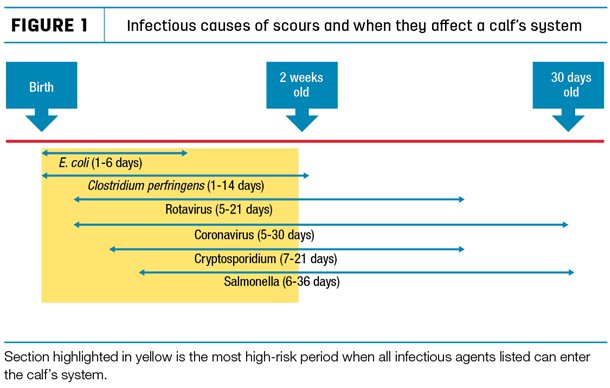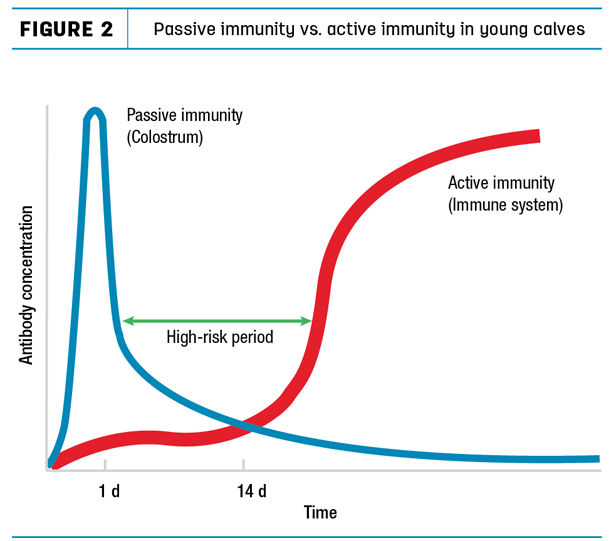Most cattlemen curse scours because of the associated stress and death loss to young calves.
Even once a calf is cured of scours, losses can still occur. A calf that has a bout of scours can lose up to 20 pounds of growth between birth and weaning. That loss of 20 pounds equates to approximately $25 loss per calf if the calf is weaned at 500 pounds.
This can be very costly, especially if scours affects a high percentage of your herd. Also, if you are thinking about retaining replacement heifers, heifers that were treated for scours are three times more likely to calve at later than 30 months old.
Scours is a multifaceted disease and can be triggered by either infectious or non-infectious causes. Non-infectious causes will exacerbate infectious causes, creating an environment for the infectious causes to inhabit.
That is why it is important to recognize non-infectious causes and how we can control them. Fortunately, non-infectious causes are relatively easy to remedy because they are mostly managerial.
Typical non-infectious causes are environment, calf stress and nutrition of the cow prior to calving. Inadequate nutrition of the dam, specifically during the last trimester, decreases the quality and quantity of colostrum, which is important in providing passive immunity to calves until their innate immune system kicks in.
By shortchanging the cow’s nutrition, specifically in energy and protein, her calf can become deficient in vitamins A and E, which are associated with a greater risk of calf scours. Cows on a lower plane of nutrition will also have a harder time calving due to decreased energy, which can cause stress on the calf.
A calf that is stressed at birth will have a weakened immune system and will generally take longer to get up and nurse. This means less colostrum and a greater chance of missing the window of absorbing those all-important antibodies.
To reduce the incidence of non-infectious causes, cows should be fed enough protein and energy to meet their requirements (55 to 60 percent total digestible nutrients and 8 percent crude protein), especially in their last trimester.
Cows receiving adequate nutrition will have an easier time calving, resulting in a less stressful birth for the calf. Also, keeping pens clean and rotating pastures will help reduce the bacteria load calves are exposed to.
Infectious causes of scours are bacteria, viruses and parasites that attack the lining of the gut. Some of the most common causes of infectious scours are E. coli, salmonella, rotavirus, coronavirus and coccidia (Figure 1).
 Calves less than 2 weeks old are at the highest risk of scours. At this point of age, passive immunity from the dam is going away while innate immunity is still ramping up but not fully active (Figure 2).
Calves less than 2 weeks old are at the highest risk of scours. At this point of age, passive immunity from the dam is going away while innate immunity is still ramping up but not fully active (Figure 2).
How can we help prevent the occurrence and spread of scours?
Beginning with the cow and calf, a calf should ingest 1 to 2 quarts of colostrum in its first two to four hours of life, and by 12 hours old, it should have consumed 1 gallon of colostrum.
This timeline is extremely important as, within the first 24 hours after birth, the percent immunoglobulin absorption by the calf decreases dramatically, with almost no absorption after 24 hours (Figure 3).
 Maternally, as the cow transitions from colostrum to milk, the concentration of antibodies decreases.
Maternally, as the cow transitions from colostrum to milk, the concentration of antibodies decreases.
Calves’ active immune systems increase in activity as they age. As a result, older calves, although exposed to scours-causing agents, can mount an immune response and prevent the disease.
Commingling calves of multiple ages is the easiest way to transfer scours. Older calves shed scour pathogens, exposing younger calves to the disease. This can result in a vicious cycle of scours which can have a huge effect on the producer’s bottom line.
Rotational calving
One method to prevent outbreaks of scours in susceptible calves is by implementing rotational calving. The benefit of rotational calving is that it prevents contact between young and old calves, lessening the exposure of newborn calves to pathogens.
This means the severity of the disease does not increase, and the age at disease onset does not decrease as the calving season progresses.
Similar to the idea of Sandhills calving, rotational calving keeps calves in small groups of similar ages. When using the Sandhills calving method, cows close to calving are kept in a large corral or pasture.
At the end of two weeks, any cows that have not calved are moved to a new corral or pasture, leaving all the cows with calves in the first area. This continues until all the cows have calved. Once the youngest calf in each group is 4 weeks old, cow-calf pairs can be commingled.
The main reason this system works is because it allows calves to be born on new, clean and dry fields, altering the reproductive cycle of pathogens and thus reducing exposure and transmission. This method also allows cow-calf pairs to disperse as much as possible in these smaller calving groups, giving them multiple areas to bed down.
Remember that in the first few weeks of life, calves have limited ability to combat disease-causing pathogens. If they are continually exposed to high levels of pathogens by older calves that have built up immunity, it will increase their risk of contracting scours.
Some things to contemplate when considering implementing rotational calving is the availability of pasture. All pastures used during calving need to be easily accessible so that, if there is a problem, cattle can be moved to a barn or calving chute for assistance.
An easy method of creating multiple pastures is to divide historical calving pastures using temporary fencing, keeping in mind that all pastures will need access to water, feed and shelter/wind break.
Also consider the number of calves that will be born in a two-week period. Producers using timed synchronization and A.I. should expect more than half of your calf volume to be born in a two-week period.
To counteract this huge influx of newborn calves, consider possibly moving cows every four to five days instead of every two weeks. Sorting cows by their calving dates is one final tip when using rotational calving. This will allow you to have smaller groups of cows to check and move at a time.
Scours is a multifaceted disease. No one form of prevention will keep scours out of your herd. But a combination of vaccination, good cow nutrition and calving management can help in the mitigation of a scours outbreak. ![]()
PHOTO: Scours is a multifaceted disease. No one form of prevention will keep scours out of your herd. But a combination of vaccination, good cow nutrition and calving management can help in the mitigation of a scours outbreak. Photo by Staff.

-
Carmen Willmore
- Extension Educator
- University of Idaho
- Email Carmen Willmore







